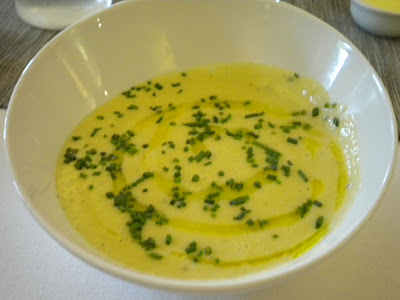Vichyssoise soup
 A very taste leek and potato soup served warm garnished with chives.
A very taste leek and potato soup served warm garnished with chives.***
Roast rack of lamb with madeira sauce and wild mushrooms
Roast rack of lamb with madeira sauce and wild mushrooms
***
Seasonal fruit with orange sabayon and praline
Seasonal fruit with orange sabayon and praline
A very simple, but effective dessert. Unfortunately we didn't get to make the sabayon.
Today's top tips:
- Vegetables that grow under the ground should be brought to the boil from cold. Vegetables that are grown above the ground should be plunged into boiling water.
- The wetter a bread dough the lighter the bread will be.
- A humid oven gives a crusty bread.
- Slash dough into quarters before proving increases the surface area and will speed up/increase the proving.
- A blue steak will have an internal temperature of 37°C, rare is 50°C, medium-rare is at 55°C and medium is at 60°C. These temperatures apply to all meats. I'm not bothered about any other stages of cooking...
- Meat should be rested for about half as long as the cooking time and as it rests the temperature will increase so cooking needs to stop before the required temperature is reached.
- When seasoned correctly, pepper should give a gentle heat at the back of the mouth/throat.
- A drop of white wine vinegar added to a cracked egg before poaching will help the white to coagulate (and also ensure eggs are kept separate if cooking in large batches).
- Dried herbs and tomato purée should be cooked out (just like spices).
- A tomato vine can be used to season.
- Blitzed up tomato seeds and juice creates a strong liquor worthy of adding to sauces.
- Caramelisation means flavour!
- The size of the raw sugar crystal is vital when trying to make caramel. Soft sugars are so fine that they will burn very easily. [Hence the difficulty in making my Angel Delight!]
- Shallots are sweeter and have a more delicate flavour than brown onions.
- Sauces can be seasoned with salt, pepper, cream, sugar and lemon juice (arguable this should always be used).
- As sauces are reduced the "note" of the boiling liquid will change at the crucial point.
- Lightly season the cut side of meat just before serving.
- A fish filleting knife can be used to prepare fruit and for carving.
- Reheating blanched vegetables in salted boiling water with a splash of oil will season them and give them a nice shine.
- Lamb fat can be rendered out just like duck fat by starting in with a cold pan. This also means a consistent brown skin colour should be achieved.



No comments:
Post a Comment